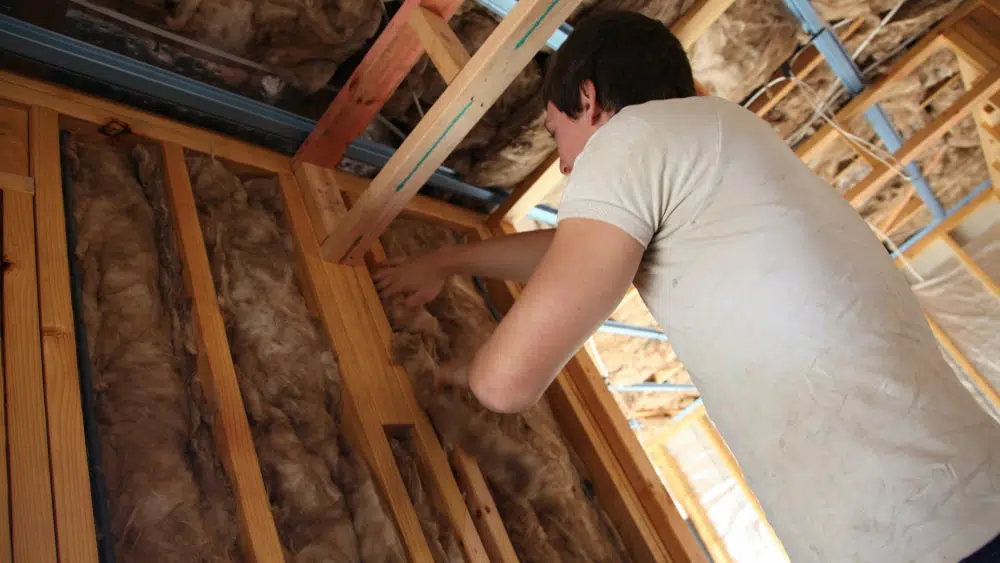
While numerous factors go into choosing the siding for your new home, such as your climate, budget and the architectural style of your new home, it’s also important to evaluate the insulation you may require. The level of insulation your home needs depends in part on your climate and the materials you choose for the exterior of your house.
Insulation between your exterior and interior walls can have a major impact on your energy costs. The EPA estimates that air sealing a home and adding insulation to attics, floors over crawl spaces and accessible basement joists can save an average of 11 percent in total energy costs. Insulating your walls during construction can improve the performance of your heating and air conditioning system, keep your home more comfortable, save you money and is better for the environment. In addition, insulation protects your home from outside elements and can reduce moisture that could cause mold or attract insects.
Types of Siding and Insulation Needs
Vinyl, wood and fiber-cement are among the most popular types of siding, but you may also be considering stucco, stone veneer and brick veneer for the outside of your home. Depending on the material, the siding itself may not offer much insulation for your home.
Your contractor or builder may refer to the “R-value” of your insulation options. R-value refers to the resistance of your insulation to heat flow. The higher the R-value, the more it resists hot and cold air and stops it from flowing through your home. The R-value you need depends in part on the level of energy efficiency you hope to achieve and your climate. Energy Star’s insulation map shows the regional differences for R-values. In most regions, Energy Star recommends adding an R-5 or R-6 level of insulation beneath new siding.
Most types of siding have an R-value of less than one, so you can see that you’re likely to need some additional insulation no matter which material you choose. Wood typically has the highest R-value among siding options, but it too is less than R-1 and requires more maintenance than some other materials.
Types of Insulation
To increase your energy efficiency and to protect your home, you may want to consider adding one type of insulation or combining two or more insulation options for an airtight home. Most new homes include house wrap in addition to insulation. In many areas, house wrap is mandated by the building code. House wrap, placed between the exterior walls and the insulation, protects your home from moisture and slows or stops the transfer of warm or cold air into your home.
The most common types of insulation that can be installed underneath new siding include:
- Foam insulation. Foam insulation is blown into the cavity between your siding and your interior walls. It works well with house wrap to prevent moisture from entering your home. An advantage of foam insulation is that the sprayed-on foam can reach into crevices and seal them, while other forms of insulation may not be as airtight. The R-value of foam insulation varies according to the type of insulation and how much foam is sprayed, generally providing an R-value between 3.7 and 6.5 per inch. Foam insulation costs approximately $0.44 to $1.50 per square foot.
- Foil-backed insulation. Foil-backed insulation has a heat-reflecting foil side attached to the insulation that helps reduce heat exposure to your home. It’s especially effective in warmer climates. In colder climates, you may need to use another form of insulation in addition to foil-backed insulation. While R-values vary, many foil-backed insulation products have an R-value of just R-1. Foil-backed insulation costs from $0.10 to $0.90 depending on whether it has foil on one or two sides.
- Insulated vinyl siding. Insulated vinyl siding is vinyl siding with an attached backing of solid rigid-foam insulation. Attaching the insulation to the siding makes the materials more resistant to warping and movement. In addition, insulated vinyl siding has an added R-value of R-2 to R-7, which is helpful but may not achieve as much energy efficiency as separate insulation projects. Insulated vinyl siding may cost 20 percent to 50 percent more than standard vinyl siding depending on the quality of the siding. Some builders prefer to use insulated vinyl siding because of its added strength and rigidity compared to standard vinyl siding.
- Fiberglass batting. Soft and flexible fiberglass batting is a popular choice for insulation in newly built homes because it’s easy to install before the interior walls are in place. Fiberglass ranges from R-11 to R-38 insulation. The cost to install fiberglass batting on a 10-square-foot wall is approximately $3.40 to $4.00.
- Rigid-foam insulation board. These panels, typically installed along exterior walls, come in a variety of materials and offer protection against moisture as well as the transfer of hot or cold air. Rigid-foam board ranges from R-1 to R-15 insulation and costs about $10 to install on a 10-square-foot wall.
Is Siding Insulation Worthwhile?
The cost of adding insulation to your home depends on the quality of the materials you choose, the size of your home, your climate and labor costs in your area. Locations with extreme temperatures are likely to require more insulation and perhaps a combination of insulation materials, while homes in more temperate climates may require less insulation.
While adding insulation to an existing home can be more complicated, installing insulation between your interior and exterior walls can be a simple part of the construction process when you’re building a new home. The long-lasting impact of this insulation can lower your utility bills and improve the comfort and performance of your home without adding significant cost to the project.

Michele Lerner is an award-winning freelance writer, editor and author who has been writing about real estate, personal finance and business topics for more than two decades.
 2021 Overview of Closing Costs in Colorado
2021 Overview of Closing Costs in Colorado